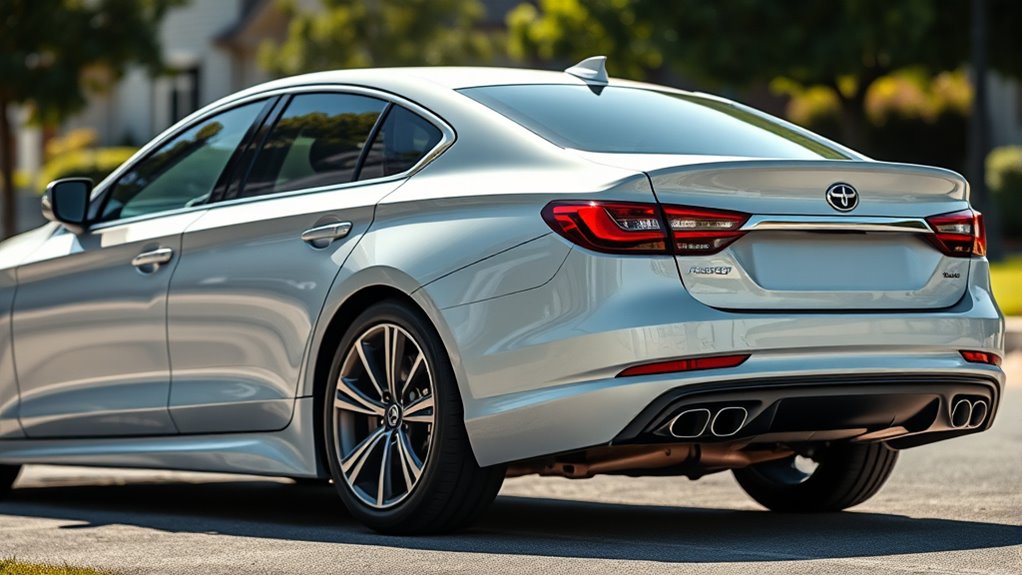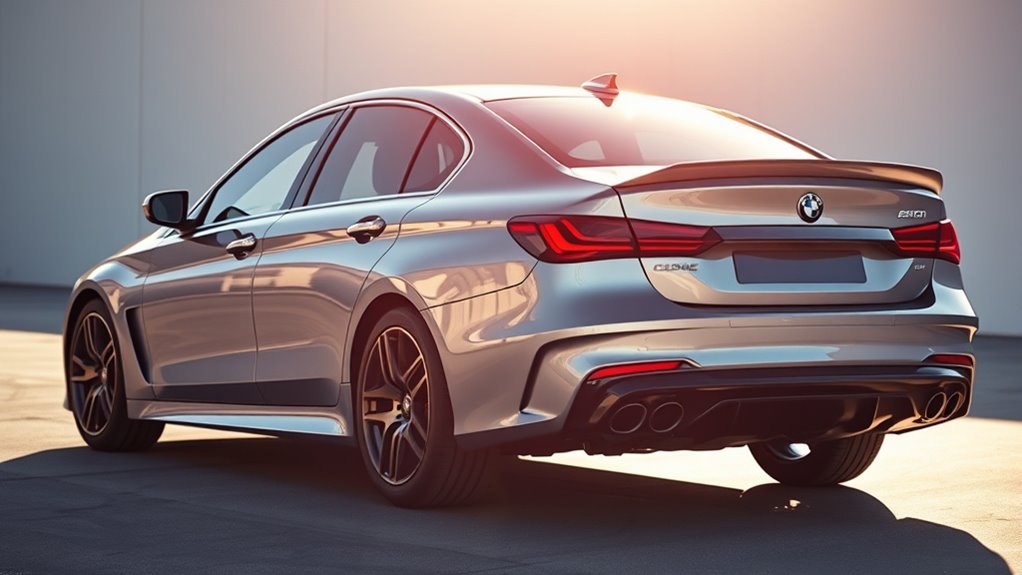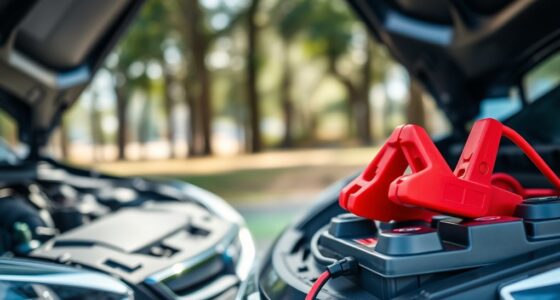F1 aerodynamics principles have quietly influenced your family sedan to improve safety, stability, and efficiency. Features like streamlined body contours, rear spoilers, and airflow management techniques help reduce drag, manage turbulence, and enhance ride comfort. These advanced designs borrow from racing strategies, making your daily drive smoother and more stable without you noticing. If you’re curious how these high-performance ideas are scaled down for everyday use, keep exploring—they’re working behind the scenes to improve your driving experience.
Key Takeaways
- Family sedans incorporate streamlined body shapes and features like flush door handles to reduce air resistance, inspired by F1 aerodynamics.
- Roof fins and rear spoilers manage airflow, decreasing turbulence and wind noise, similar to F1 downforce techniques.
- Underbody panels and diffusers are used to streamline airflow beneath the vehicle, enhancing stability and fuel efficiency.
- Aerodynamic wheel covers and molded side mirrors minimize turbulence around wheels, echoing F1 wheel management strategies.
- Overall, these F1-inspired features improve ride stability, noise reduction, and fuel economy in everyday family vehicles.

While Formula 1 cars are renowned for their advanced aerodynamics, many of these principles are surprisingly applicable to family sedans. You might not realize it, but the way your car handles airflow is influenced by concepts originally designed for racing. These ideas, primarily focused on drag reduction and airflow management, help improve fuel efficiency, stability, and overall comfort. By understanding how these techniques trickle down from F1 technology, you can appreciate the smarter engineering behind your everyday vehicle.
Drag reduction is a key goal in both racing and family car design. F1 teams obsess over minimizing air resistance to boost speed and efficiency. In your sedan, engineers incorporate similar ideas, such as smooth body contours and streamlined shapes, to reduce drag. Features like flush door handles, carefully molded side mirrors, and aerodynamic wheel covers are all intended to manage airflow smoothly around the vehicle. These small design choices cut down on turbulence and drag, helping your car use less fuel and move more effortlessly through the air. It’s like having a gentle breeze guiding your car along the road, rather than fighting against gusts of resistance.
Airflow management plays an equally important role. In racing, teams use complex aerodynamics to channel air efficiently, creating downforce that presses the car onto the track for better grip. Although family sedans don’t generate downforce at racing levels, they still benefit from airflow control to improve stability and reduce wind noise. Features like rear spoilers or subtle roof fins aren’t just aesthetic; they help manage airflow behind the vehicle, reducing turbulence that can cause drag and noise. This means your car remains steadier at highway speeds, with less buffeting from crosswinds, and you enjoy a quieter, more comfortable ride. These aerodynamic elements are often inspired by F1 techniques, scaled down and adapted for everyday use.
The principles of airflow management extend to how your car’s underbody is designed as well. Undertrays and diffusers, though more common in race cars, influence how air flows beneath your vehicle, further reducing drag and improving efficiency. While your family sedan might not have elaborate diffusers, subtle design features like underbody panels help streamline airflow underneath, preventing turbulent air from creating drag. This not only enhances fuel economy but also contributes to better handling and ride quality.
Additionally, the implementation of cultural intelligence in automotive design demonstrates how cross-disciplinary insights can lead to innovative solutions, even in seemingly unrelated fields like vehicle aerodynamics.
In essence, many features you see on modern family sedans are direct descendants of high-performance F1 aerodynamics. They work together to reduce drag and optimize airflow, making your driving experience safer, smoother, and more efficient. You might not be racing on a circuit, but the same aerodynamic principles that help F1 cars carve through the air are quietly working to improve your everyday drive.
Frequently Asked Questions
How Do F1 Aerodynamics Improve Fuel Efficiency in Sedans?
F1 aerodynamics improve fuel efficiency in sedans by reducing drag, making it easier for the vehicle to move through the air. When drag decreases, your car requires less engine power, which boosts fuel economy. Advanced aerodynamic features like streamlined body shapes and improved airflow management help your family sedan cut through the air more efficiently, saving you money on fuel and reducing emissions, just like in racing cars.
Are F1 Aerodynamic Features Safe for Everyday Family Use?
You might wonder if F1 aerodynamic features are safe for your family vehicle. While these designs boost performance, they’re carefully engineered to meet safety standards and won’t compromise your family’s security. Aerodynamic safety focuses on stability and control, making your sedan more reliable. So, yes, many advanced aerodynamic features are safe for everyday family use, providing enhanced safety without sacrificing comfort or peace of mind.
How Much Does Incorporating F1 Aerodynamics Increase Vehicle Cost?
You’ll find that incorporating F1 aerodynamics into your vehicle increases costs due to design considerations and advanced materials. These features require precise engineering and testing, which drive up manufacturing expenses. While some aerodynamic enhancements may be affordable, high-performance elements can markedly affect your budget. Expect to pay more for improved stability and efficiency, but remember, the added safety and performance benefits often justify the extra investment.
Can F1-Inspired Aerodynamics Be Customized for Different Sedan Models?
They say “the devil is in the details,” and when it comes to F1-inspired aerodynamics, customization options are key. You can tailor aerodynamic features to fit different sedan models, enhancing performance and style. Manufacturers are increasingly offering aerodynamic tailoring, allowing you to personalize your vehicle’s look and efficiency. While not all sedans can fully mimic racing aerodynamics, thoughtful customization options let you incorporate some F1-inspired elements seamlessly.
What Maintenance Challenges Arise From F1-Inspired Aerodynamic Components?
You might face maintenance challenges with F1-inspired aerodynamic components, like increased ventilation issues that can cause overheating or fogging. These parts are often delicate, leading to paint damage if not handled carefully during cleaning or repairs. You’ll need to regularly inspect and maintain these components to prevent airflow problems and preserve their appearance, ensuring your sedan stays sleek without compromising performance or aesthetics.
Conclusion
So, next time you cruise in your family sedan, imagine a tiny F1 car zooming down the track. Despite their size difference, both rely on sleek aerodynamics to cut through air—one to win races, the other to save fuel and improve comfort. It’s like a race car’s speed and a sedan’s practicality sharing the same secret. Hidden in everyday drives, F1 aerodynamics quietly make your journey smoother, faster, and more efficient.










